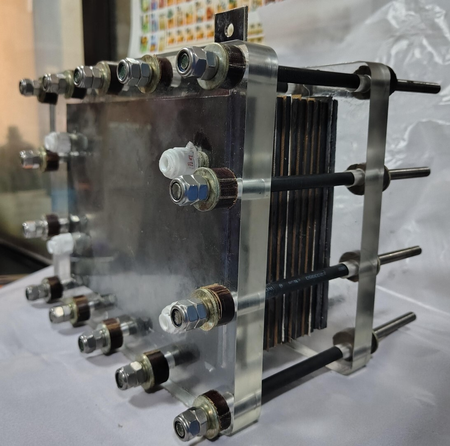
New Delhi, Aug 27 (IANS) Researchers at the Indian Institute of Technology (IIT) Madras have developed a cost-effective and indigenous alkaline seawater electrolyser that can produce hydrogen without relying on hard-to-find rare metals.
The advancement addresses both the cost of current technologies as well as the pressing issue of scarcity of freshwater that is being used to synthesise the large-scale hydrogen production.
The affordable catalyst that resists seawater corrosion and efficiently produces hydrogen and oxygen.
The major technical issue with using seawater instead of fresh water to produce hydrogen is that its high chloride level can corrode electrodes, especially the anode, and reduce the efficiency of conversion.
While conventional catalysts use costly, scarce ‘noble metals’ like ruthenium and iridium, the new technology uses abundant seawater instead of fresh water and cost-effective catalysts and separators.
“In place of pure or fresh water, we used alkaline seawater and developed an electrolyser using cost-effective transition metal-based catalysts that can catalyse both oxygen and hydrogen evolution reactions. The uniqueness of the technology is the use of transition bimetals-based catalysts that are more selective towards oxygen evolution reaction than hypochlorite formation when alkaline seawater is used as electrolyte,” Prof. S. Ramaprabhu, Physics Department, IIT Madras, told IANS.
Under the aegis of the Union Ministry of New and Renewable Energy, India aims to become the global hub and a leading producer of Green Hydrogen by 2030.
However, nine litres of water is required to produce one kilogram of green hydrogen, which leads to a requirement of 50 billion litres of de-mineralised or fresh water to produce 5 million tonnes of hydrogen.
The new technology was successfully scaled up from a single cell to a nine-cell stack, resulting in the production of up to 50 litres of hydrogen per hour when powered by commercial solar photovoltaic systems to produce green hydrogen.
“India stands to gain significantly from indigenous green hydrogen to reduce pollution and depletion of fossil fuels. Besides, by using H2 fuel cells in hydrogen-driven vehicles, clean energy conversion will be achieved. Green H2 can be further used in the steel industries, the chemical industry for manufacturing ammonia and fertilisers. The use of GH2 in the green ammonia production will reduce reliance on fossil fuels and carbon emissions,” Ramaprabhu said.
–IANS
rvt/




